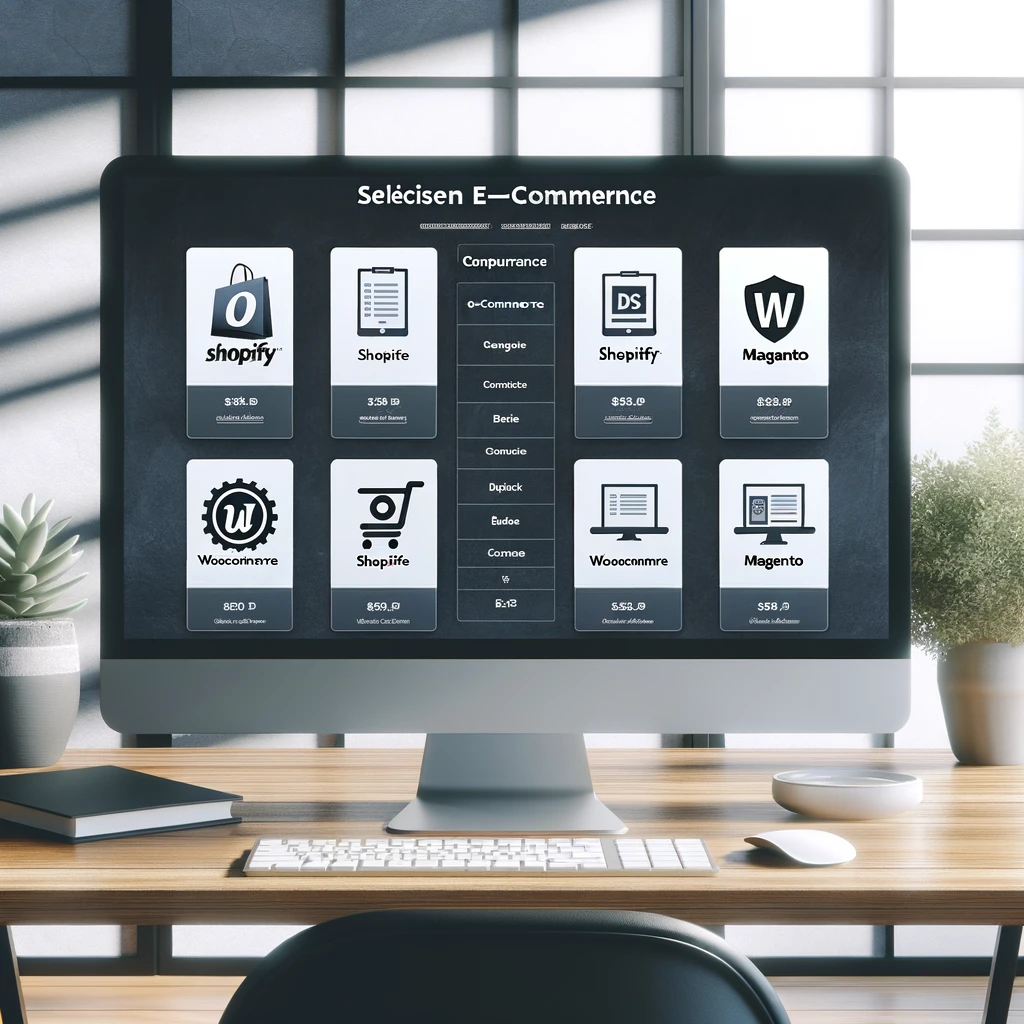Introduction

Hey there, local entrepreneurs and business owners! Are you looking to tap into the bustling e-commerce scene right here in Columbia? Whether you’re just starting out or looking to expand your online presence, understanding the ins and outs of e-commerce web development is crucial. It’s not just about having a digital storefront—it’s about creating an engaging, efficient, and effective online shopping experience that resonates with your customers.
In this guide, we’ll dive deep into what makes for a successful e-commerce website. From choosing the right platform that fits your business model to ensuring your site is a breeze for customers to navigate, we’ve got you covered. We’ll also touch on the legal stuff to keep everything on the up and up, and share some savvy marketing tips to get your products flying off the virtual shelves.
Ready to get started? Let’s embark on this digital journey together, equipping you with the knowledge to build a thriving online store that stands out in the competitive Columbia market. It’s time to transform your business ideas into a flourishing online reality!
Planning Your E-commerce Website

Hello again! So, you’re ready to dive into the e-commerce world. Great decision! But before we jump into the deep end, let’s start with some solid planning. Think of it as your digital blueprint—it’s what will guide your online store from just a cool idea to a fully functional business.
Understanding Your Audience
First things first, who are you selling to? Knowing your audience is like knowing whom you’re inviting to a party. What do they like? What do they need? Whether your audience is tech-savvy millennials in Columbia or busy parents looking for quick shopping solutions, tailoring your site to meet their expectations is key.
Defining Business Objectives
Next up, what are your goals? Every successful venture needs clear objectives. Are you looking to drive sales, increase brand awareness, or maybe provide a seamless shopping experience? Setting these goals early on will help you design a site that not only looks good but also performs effectively.
By the end of this planning phase, you should have a clear understanding of who your customers are and what you want to achieve with your e-commerce site. With these insights, you’re better equipped to make informed decisions as you move forward in developing your online store.
Choosing the Right Platform

Alright, now that we’ve laid the groundwork with some smart planning, let’s move on to one of the most crucial decisions you’ll make for your e-commerce venture—choosing the right platform. Think of your platform as the foundation of your digital storefront. It needs to be sturdy, reliable, and supportive of your business’s unique needs.
Overview of E-commerce Platforms
There’s a variety of e-commerce platforms out there, each with its strengths and quirks. Here’s a quick rundown of some popular choices:
- Shopify: Loved for its user-friendliness and comprehensive features, Shopify is a go-to for many startups and established businesses alike. It’s perfect if you want something that’s out-of-the-box ready with plenty of customization options.
- WooCommerce: If you’re already comfortable with WordPress, WooCommerce seamlessly integrates with it, transforming your site into a powerful e-commerce store. It’s highly customizable, which is great for those who have specific visions.
- Magento: Need something robust for a larger operation? Magento offers advanced features that are ideal for enterprise-level businesses. It’s complex but incredibly powerful.
Local Considerations
When picking a platform, think about what works best in Columbia. Consider factors like local payment gateways, shipping logistics, and even language options if you’re catering to a bilingual market. The right platform will not only meet your current needs but also grow with your business.
Choosing the right platform is a balancing act between what your business needs and what each platform offers. Take your time, do your research, and maybe even test a few out to see what feels right. Remember, this decision sets the stage for everything that follows in your e-commerce journey.
Designing for Usability

Alright, now that you’ve chosen the perfect platform, it’s time to dive into designing your e-commerce site. But we’re not just talking about making it look pretty—usability is the name of the game here. After all, what good is a stunning website if your customers can’t find what they’re looking for or navigate through it smoothly?
User Experience (UX)
Focus on creating an intuitive user experience that guides visitors effortlessly from the homepage to checkout. Here are a few key elements to consider:
- Navigation: Keep it simple and intuitive. Categories should be clearly labeled, and searching for products must be a breeze.
- Load Times: Speed is essential. A fast-loading site keeps users happy and reduces bounce rates, especially on mobile devices.
- Call to Action: Make your CTAs clear and compelling. Whether it’s “Add to Cart”, “Learn More”, or “Check Out”, each button should stand out and be easy to find.
Mobile Optimization
With more and more people shopping on their smartphones, your e-commerce site needs to perform flawlessly on mobile devices. This means:
- Responsive Design: Ensure your site looks great and functions well on all screen sizes.
- Touch Interactions: Buttons and links should be easy to tap, and text should be easily readable without zooming in.
- Speed Optimization: Mobile users are often on the go, so your site’s load time should be as quick as possible.
Designing with usability in mind is crucial for keeping visitors engaged and turning them into customers. It’s about creating a seamless flow that makes shopping online a pleasure, not a chore.
Implementing Essential Features

Now that we’ve got the design dialed in, let’s talk about beefing up your e-commerce site with some must-have features. These are the nuts and bolts that make your site not just good-looking, but also highly functional and secure.
Product Pages
Your product pages are where the magic happens—they convert browsers into buyers. Make sure these pages are clear, informative, and enticing:
- High-Quality Images: Use crisp, high-resolution photos from multiple angles.
- Detailed Descriptions: Provide thorough information that answers all potential questions a customer might have.
- Reviews and Ratings: Allow customers to leave feedback, which not only boosts confidence in your products but also helps with SEO.
Checkout Process
A smooth checkout process is crucial to prevent cart abandonment. Here’s how to keep it streamlined:
- Simplify the Steps: Keep the checkout process short and sweet. Minimize the number of screens a user has to go through.
- Multiple Payment Options: Offer a variety of payment methods to cater to all your customers’ preferences.
- Guest Checkout Option: Not everyone wants to set up an account. A guest checkout can speed up the process and reduce barriers to purchase.
Security Features
Security is non-negotiable when you’re dealing with customers’ personal and payment information:
- SSL Certificate: This is a must for encrypting data and securing transactions.
- Payment Security: Use trusted payment gateways that comply with the latest security standards to protect both you and your customers.
- Privacy Policy: Clearly state how you handle customer data and comply with local data protection laws.
By integrating these essential features, you ensure that your e-commerce site isn’t just a place to shop, but a safe, enjoyable, and efficient online experience that customers will return to time and again.
Legal and Regulatory Compliance

Okay, let’s get down to one of the less glamorous, but absolutely essential, parts of running an e-commerce site—staying on the right side of the law. Legal and regulatory compliance might not be the most exciting topic, but it’s critical for protecting your business and your customers.
Local Regulations
First up, you need to understand the local e-commerce laws in Columbia. This includes everything from business licenses to tax obligations:
- Business Licensing: Make sure your e-commerce business is properly registered and licensed to operate in Columbia.
- Sales Tax: Be aware of the local tax regulations and ensure your site is set up to handle these correctly. This might involve automated tax calculations at checkout.
Privacy and Data Protection
With the rise of online shopping, data privacy has never been more important:
- Privacy Policy: You must have a clear privacy policy that tells your customers exactly what data you collect and how you use it.
- Data Security: Implement strong security measures to protect customer data. This includes using secure servers and complying with PCI DSS if you handle credit card information.
Accessibility Compliance
Don’t forget about making your website accessible to all users, including those with disabilities:
- ADA Compliance: Ensure your website meets ADA standards so that everyone has equal access to your services.
Navigating these legal waters can be tricky, but it’s absolutely vital for building trust with your customers and avoiding any legal issues down the road.
Marketing Your E-commerce Site

Alright, your e-commerce site is up and running, compliant with all the legal stuff, and looking fabulous. Now, let’s chat about how to get people buzzing about your store. Marketing your site effectively is crucial to driving traffic and converting that traffic into sales. Here are some strategies to help you spread the word and attract customers.
SEO Strategies
Start with search engine optimization (SEO) to make sure your site ranks well on search engines:
- Keyword Research: Find out what potential customers are searching for and optimize your content to include those keywords.
- On-Page SEO: Ensure your site’s structure, meta descriptions, and image alt texts are optimized for search engines.
- Local SEO: Since you’re operating in Columbia, localize your SEO efforts to target local customers more effectively.
Social Media and Email Marketing
Social media and email are powerful tools for connecting with customers:
- Social Media: Use platforms like Instagram, Facebook, and Twitter to engage with your audience. Post regular updates, promotions, and behind-the-scenes content to keep your audience engaged.
- Email Marketing: Build a mailing list and keep your subscribers informed about new products, sales, and special events. Personalized emails can be very effective in converting leads into sales.
Content Marketing
Create valuable content that your audience wants to consume:
- Blog Posts: Write about topics related to your products that your audience might find helpful or interesting.
- Videos: Product demos, tutorials, or customer testimonials can be great for engaging viewers and giving them a closer look at what you offer.
Marketing isn’t just about selling; it’s about creating relationships and building trust with your customers. With the right approach, you can turn your e-commerce site into a thriving community of loyal customers.
Analytics and Improvement

We’ve covered setting up and marketing your e-commerce site, but the journey doesn’t stop there. Let’s talk about fine-tuning your operations with analytics and ongoing improvements—a crucial step to keeping your online store at the top of its game.
Setting Up Analytics
To start, you’ll want to integrate analytics tools into your website. Tools like Google Analytics provide invaluable insights into how visitors interact with your site:
- Traffic Sources: Understand where your visitors are coming from—search engines, social media, or direct visits.
- User Behavior: Track which products are popular, how visitors navigate your site, and where you might be losing them.
Setting up these tools correctly will give you a clear picture of what’s working and what isn’t, enabling you to make data-driven decisions.
Customer Feedback
Never underestimate the power of listening to your customers. Feedback can be gathered through:
- Surveys: Simple questionnaires can help you gauge customer satisfaction.
- Reviews: Encourage users to leave reviews, which not only improve your credibility but also give you direct feedback on your products.
Continual Improvement
E-commerce is a dynamic field, and staying competitive means continually adapting and improving. Use the insights you gain from analytics and customer feedback to:
- Optimize Your Website: Make adjustments to improve user experience and increase conversion rates.
- Enhance Your Marketing: Refine your marketing strategies based on what the data tells you about your audience’s preferences and behaviors.
Think of your e-commerce site as a living entity that needs care and attention to grow. By regularly analyzing your performance and making the necessary adjustments, you can ensure that your business not only survives but thrives.
Conclusion

Well, there you have it—your comprehensive guide to launching and nurturing your e-commerce site right here in Columbia. From initial planning and choosing the right platform to implementing essential features and diving deep into marketing, we’ve covered the whole nine yards. But remember, the journey doesn’t end here. Running an e-commerce site is an ongoing adventure that involves constant learning, adapting, and improving.
Keep Evolving
The digital world moves fast, and staying ahead means keeping up with new technologies, customer expectations, and marketing trends. Always be on the lookout for new ways to enhance your site and customer experience.
Stay Connected
Engage with your customers regularly. Listen to their feedback and let it guide your improvements. Building strong relationships will turn one-time buyers into loyal customers.
Never Stop Learning
Finally, keep educating yourself. Whether it’s through online courses, webinars, or articles, the more you know, the better equipped you’ll be to make smart decisions that drive success.
Launching your e-commerce site is just the beginning of a thrilling ride. Embrace the challenges and opportunities it brings, and enjoy the journey of growing your business online. Here’s to your success—may your digital store flourish and your conversions be many!
Additional Resources
Congratulations on making it through our comprehensive guide to e-commerce web development in Columbia! To keep you moving forward and ensure you have all the tools and knowledge at your fingertips, here are some additional resources that can help you deepen your understanding, refine your skills, and stay updated with the latest trends in e-commerce.
Online Learning Platforms
- Coursera: Offers a range of courses in e-commerce, digital marketing, and web development taught by university professors and industry experts.
- Udemy: Features extensive tutorials on using specific e-commerce platforms like Shopify and WooCommerce, as well as general e-commerce strategies.
Blogs and Websites
- E-Commerce Times: Provides news, analysis, and advice on e-commerce.
- Practical Ecommerce: Shares actionable tips and insights on improving e-commerce sites and marketing strategies.
Books
- “E-Commerce 2021-2022” by Kenneth C. Laudon and Carol Guercio Traver: A detailed book covering various aspects of operating an online business.
- “One Click: Jeff Bezos and the Rise of Amazon.com” by Richard L. Brandt: Offers insights into the mindset and strategies behind one of the most successful e-commerce companies.
Tools
- Google Analytics: Essential for tracking website performance and consumer behavior.
- SEMrush: A comprehensive tool for SEO, competitor analysis, and social media monitoring.
Podcasts
- The E-Commerce Influence Podcast: Provides strategies and ideas for e-commerce marketing and optimization.
- E-Commerce MasterPlan: Hosts various experts discussing their experiences and tips on growing an online business.
Networking
- Meetup.com: Search for e-commerce or digital marketing groups in Columbia. These meetings can be a great way to connect with peers and experts.
- LinkedIn Groups: Join e-commerce-related groups to network, share ideas, and learn from professionals worldwide.
These resources will help you continue learning and adapting, keeping your e-commerce business vibrant and competitive. Whether it’s through further education, networking, or staying on top of industry news, maintaining a proactive approach is key to your success. Happy selling!